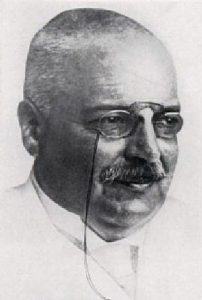
Alois Alzheimer, whose medical research led to the first characterization of the disease now named after him
A promising development toward the prevention and cure of Alzheimer’s and Parkinson’s disease has been published in the past week. We briefly review this development below.
Alzheimer’s and Parkinson’s disease: the insulin clue
The causation of Alzheimer’s Disease (AD) has stumped medical researchers for decades. The dominant causal factor was assumed to be the amyloid plaques or tau tangles seen in the autopsied brains of AD sufferers. But attempts to prevent the development of these plaques and tangles have not halted the course of the disease. This has increased the likelihood that the amyloid and tau proteins are not the cause of AD but side effects.
AD is the leading cause of dementia, with an estimated 5.5 mn. afflicted in the US and 24 mn. worldwide. Diabetes is one of the risk factors for AD. It’s also a risk factor for another brain disease, Parkinson’s Disease (PD). According to WebMD, “Finnish researchers have found that people with type 2 diabetes were more than 80% more likely to be later diagnosed with Parkinson’s disease than others.”
What’s the connection between diabetes on the one hand and the quite different AD and PD on the other? Professor of Neuroscience, Lancaster University writes:
“In diabetes, insulin becomes less effective at controlling blood sugar levels. But insulin does a lot more than just control blood sugar; it is a “growth factor”. Neurons (brain cells) are very dependent on growth factors, and if they don’t get enough, they die.
“The loss of insulin’s growth factor effects in the brain appear to make neurons vulnerable to stress and reduce the brain’s ability to repair damage that accumulates over time. (Neurons live as long as we do, so there is a lot of time for damage to accrue.)
“When looking at brain tissue taken from deceased Alzheimer’s patients, researchers found that insulin lost its effectiveness as a growth factor, even in people who were not diabetic. This observation suggests that diabetes drugs might be an effective treatment for people with Alzheimer’s. Some experiments showed impressive results in animal studies, and several clinical trials have started.
“Testing these drugs in animal models of another neurodegenerative disorder, Parkinson’s disease, also showed impressive effects, and two clinical trials in Parkinson’s patients showed good protective effects….
“To see any protective effect in the brain in a clinical trial is completely new, and it supports the new theory that Alzheimer’s and Parkinson’s disease are caused, at least in part, by a lack of growth factor activity in the brain. These new theories bring a fresh view on how these diseases develop and increase the likelihood of developing a drug treatment that makes a difference.”
See Dr. Holscher’s abstract and his Neuropharmacology article cited here for a technical discussion.
The takeaway for those without diabetes but at risk (or with prediabetes) is to adopt lifestyle changes — no smoking, no obesity, regular exercise, and a healthy diet. If that fails, one should consult an MD regarding an appropriate anti-diabetes medicine. But lifestyle changes are apparently more effective and should be attempted first.
The US has an abnormally high ca. 25% of the world’s Alzheimer’s patients. One suspects that is not unrelated to its high incidence of obesity, which increases the likelihood of the AD-risk factor, diabetes.
Click here to go to the previous Founders Broadsheet post (“President Trump refutes “big bark, little bite” predictions; angers allies”)

Leave a Reply